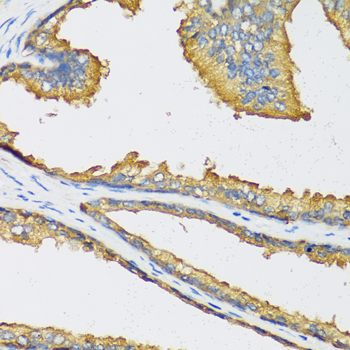Anti-CXCL11 Antibody (CAB6201)
- SKU:
- CAB6201
- Product type:
- Antibody
- Reactivity:
- Human
- Host Species:
- Rabbit
- Isotype:
- IgG
- Antibody Type:
- Polyclonal Antibody
- Research Area:
- Cell Biology
Frequently bought together:
Description
| Antibody Name: | Anti-CXCL11 Antibody |
| Antibody SKU: | CAB6201 |
| Antibody Size: | 20uL, 50uL, 100uL |
| Application: | IHC |
| Reactivity: | Human |
| Host Species: | Rabbit |
| Immunogen: | Recombinant fusion protein containing a sequence corresponding to amino acids 22-94 of human CXCL11 (NP_005400.1). |
| Application: | IHC |
| Recommended Dilution: | IHC 1:100 - 1:200 |
| Reactivity: | Human |
| Positive Samples: |
| Immunogen: | Recombinant fusion protein containing a sequence corresponding to amino acids 22-94 of human CXCL11 (NP_005400.1). |
| Purification Method: | Affinity purification |
| Storage Buffer: | Store at -20°C. Avoid freeze / thaw cycles. Buffer: PBS with 0.02% sodium azide, 50% glycerol, pH7.3. |
| Isotype: | IgG |
| Sequence: | FPMF KRGR CLCI GPGV KAVK VADI EKAS IMYP SNNC DKIE VIIT LKEN KGQR CLNP KSKQ ARLI IKKV ERKN F |
| Gene ID: | 6373 |
| Uniprot: | O14625 |
| Cellular Location: | Secreted |
| Calculated MW: | 10kDa |
| Observed MW: |
| Synonyms: | CXCL11, H174, I-TAC, IP-9, IP9, SCYB11, SCYB9B, b-R1 |
| Background: | Chemokines are a group of small (approximately 8 to 14 kD), mostly basic, structurally related molecules that regulate cell trafficking of various types of leukocytes through interactions with a subset of 7-transmembrane, G protein-coupled receptors. Chemokines also play fundamental roles in the development, homeostasis, and function of the immune system, and they have effects on cells of the central nervous system as well as on endothelial cells involved in angiogenesis or angiostasis. Chemokines are divided into 2 major subfamilies, CXC and CC. This antimicrobial gene is a CXC member of the chemokine superfamily. Its encoded protein induces a chemotactic response in activated T-cells and is the dominant ligand for CXC receptor-3. The gene encoding this protein contains 4 exons and at least three polyadenylation signals which might reflect cell-specific regulation of expression. IFN-gamma is a potent inducer of transcription of this gene. Two transcript variants encoding different isoforms have been found for this gene. |
| UniProt Protein Function: | CXCL11: Chemotactic for interleukin-activated T-cells but not unstimulated T-cells, neutrophils or monocytes. Induces calcium release in activated T-cells. Binds to CXCR3. May play an important role in CNS diseases which involve T-cell recruitment. May play a role in skin immune responses. Belongs to the intercrine alpha (chemokine CxC) family. |
| UniProt Protein Details: | Protein type:Motility/polarity/chemotaxis; Chemokine; Secreted; Secreted, signal peptide Chromosomal Location of Human Ortholog: 4q21.2 Cellular Component: extracellular space; extracellular region Molecular Function:heparin binding; protein binding; CXCR3 chemokine receptor binding; chemokine activity Biological Process: G-protein coupled receptor protein signaling pathway; cell-cell signaling; immune response; positive regulation of leukocyte chemotaxis; response to lipopolysaccharide; positive regulation of release of sequestered calcium ion into cytosol; positive regulation of cAMP metabolic process; signal transduction; chemotaxis; inflammatory response; regulation of cell proliferation |
| NCBI Summary: | Chemokines are a group of small (approximately 8 to 14 kD), mostly basic, structurally related molecules that regulate cell trafficking of various types of leukocytes through interactions with a subset of 7-transmembrane, G protein-coupled receptors. Chemokines also play fundamental roles in the development, homeostasis, and function of the immune system, and they have effects on cells of the central nervous system as well as on endothelial cells involved in angiogenesis or angiostasis. Chemokines are divided into 2 major subfamilies, CXC and CC. This antimicrobial gene is a CXC member of the chemokine superfamily. Its encoded protein induces a chemotactic response in activated T-cells and is the dominant ligand for CXC receptor-3. The gene encoding this protein contains 4 exons and at least three polyadenylation signals which might reflect cell-specific regulation of expression. IFN-gamma is a potent inducer of transcription of this gene. Two transcript variants encoding different isoforms have been found for this gene. [provided by RefSeq, Oct 2014] |
| UniProt Code: | O14625 |
| NCBI GenInfo Identifier: | 7674360 |
| NCBI Gene ID: | 6373 |
| NCBI Accession: | O14625.1 |
| UniProt Related Accession: | O14625 |
| Molecular Weight: | |
| NCBI Full Name: | C-X-C motif chemokine 11 |
| NCBI Synonym Full Names: | C-X-C motif chemokine ligand 11 |
| NCBI Official Symbol: | CXCL11 |
| NCBI Official Synonym Symbols: | IP9; H174; IP-9; b-R1; I-TAC; SCYB11; SCYB9B |
| NCBI Protein Information: | C-X-C motif chemokine 11 |
| UniProt Protein Name: | C-X-C motif chemokine 11 |
| UniProt Synonym Protein Names: | Beta-R1; H174; Interferon gamma-inducible protein 9; IP-9; Interferon-inducible T-cell alpha chemoattractant; I-TAC; Small-inducible cytokine B11 |
| UniProt Gene Name: | CXCL11 |
| UniProt Entry Name: | CXL11_HUMAN |
 | Immunohistochemistry of paraffin-embedded human prostate using CXCL11 antibody (CAB6201) at dilution of 1:100 (40x lens). |








